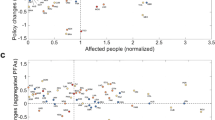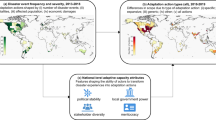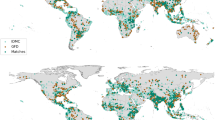Abstract
Direct economic losses result when a hurricane encounters an exposed, vulnerable society. A normalization estimates direct economic losses from a historical extreme event if that same event was to occur under contemporary societal conditions. Under the global indicator framework of United Nations Sustainable Development Goals, the reduction of direct economic losses as a proportion of total economic activity is identified as a key indicator of progress in the mitigation of disaster impacts. Understanding loss trends in the context of development can therefore aid in assessing sustainable development. This analysis provides a major update to the leading dataset on normalized US hurricane losses in the continental United States from 1900 to 2017. Over this period, 197 hurricanes resulted in 206 landfalls with about US$2 trillion in normalized (2018) damage, or just under US$17 billion annually. Consistent with observed trends in the frequency and intensity of hurricane landfalls along the continental United States since 1900, the updated normalized loss estimates also show no trend. A more detailed comparison of trends in hurricanes and normalized losses over various periods in the twentieth century to 2017 demonstrates a very high degree of consistency.
This is a preview of subscription content, access via your institution
Access options
Access Nature and 54 other Nature Portfolio journals
Get Nature+, our best-value online-access subscription
$29.99 / 30 days
cancel any time
Subscribe to this journal
Receive 12 digital issues and online access to articles
$119.00 per year
only $9.92 per issue
Buy this article
- Purchase on Springer Link
- Instant access to full article PDF
Prices may be subject to local taxes which are calculated during checkout

Similar content being viewed by others
Data availability
Data used to perform this study can be found in the Supplementary Information as an Excel spreadsheet. Any further data that support the findings of this study are available from the corresponding authors upon reasonable request.
References
Mohleji, S. & Pielke, R. Jr Reconciliation of trends in global and regional economic losses from weather events: 1980–2008. Nat. Hazards Rev. 15, 1–9 (2014).
Clark, K. in G. Michel (ed.) Risk Modeling for Hazards and Disasters 271–279 (Chaucer Syndicates, Copenhagen, 2018).
Walker, G. R., Mason, M. S., Crompton, R. P. & Musulin, R. T. Application of insurance modelling tools to climate change adaptation decision-making relating to the built environment. Struct. Infrastruct. E 12, 450–462 (2016).
Pielke, R. A. Jr. & Landsea, C. W. Normalized hurricane damage in the United States: 1925–95. Weather Forecast. 13, 621–631 (1998).
Pielke, R. A. Jr et al. Normalized hurricane damage in the United States: 1900–2005. Nat. Hazards Rev. 9, 29–42 (2008).
Bouwer, L. M. Have disaster losses increased due to anthropogenic climate change? Bull. Am. Meteorol. Soc. 92, 39–46 (2011).
SDG Indicators: Global Indicator Framework for the Sustainable Development Goals and Targets of the 2030 Agenda for Sustainable Development (UN Statistics Division, 2018); https://unstats.un.org/sdgs/indicators/indicators-list/
Murray, V. & Ebi, K. L. IPCC Special Report on Managing the Risks of Extreme Events and Disasters to Advance Climate Change Adaptation (SREX) (IPCC, Cambridge Univ. Press, 2012).
Stocker T. F. et al. in Climate Change 2013: The Physical Science Basis (eds Stocker, T. F. et al.) (IPCC, Cambridge Univ. Press, 2013).
Pielke, R. A. Future economic damage from tropical cyclones: sensitivities to societal and climate changes. Phil. Trans. Royal Soc. A 365, 2717–2729 (2007).
Mendelsohn, R., Emanuel, K., Chonabayashi, S. & Bakkensen, L. The impact of climate change on global tropical cyclone damage. Nat. Clim. Change 2, 205–209 (2012).
Increasing Concentrations of Property Values and Catastrophe Risk in the US (Karen Clark and Co, 2015); http://www.karenclarkandco.com/news/publications/pdf/KCC_Industry_Exposure_Report.pdf
Weinkle, J. The new political importance of the old hurricane risk: a contextual approach to understanding contemporary struggles with hurricane risk and insurance. J. Risk Res. https://doi.org/10.1080/13669877.2017.1378250 (2017).
Delgado, S., Landsea, C. W. & Willoughby, H. Reanalysis of the 1954–63 Atlantic hurricane seasons. J. Climate 31, 4177–4192 (2018).
Simmons, K. M., Sutter, D. & Pielke, R. Normalized tornado damage in the United States: 1950–2011. Environ. Hazards 12, 132–147 (2013).
2017: Climate Science Special Report: Fourth National Climate Assessment (eds Wuebbles, D. J. et al.) Vol. I (US Global Change Research Program, 2017); https://doi.org/10.7930/J0J964J6
Klotzbach, P., Bowen, S., Pielke, R. & Bell, M. Continental United States hurricane landfall frequency and associated damage: observations and future risks. Bull. Am. Meteorol. Soc. https://doi.org/10.1175/BAMS-D-17-0184.1 (2018).
Collins, D. & Lowe, S. P. A Macro Validation Dataset for US Hurricane Models (Casualty Actuarial Society, 2001); http://www.casact.org/pubs/forum/01wforum/01wf217.pdf
Estrada, F., Botzen, W. W. & Tol, R. S. Economic losses from US hurricanes consistent with an influence from climate change. Nat. Geosci. 8, 880–884 (2015).
Truchelut, R. E. & Steahling, E. M. An energetic perspective on United States tropical cyclone landfall droughts. Geophys. Res. Lett. 44, 12,013–12,019 (2017).
NOAA Continental United States Hurricane Impacts/Landfalls 1851–2016 (Hurricane Research Division, HURDAT, 2017); http://www.aoml.noaa.gov/hrd/hurdat/All_US_Hurricanes.html
Pielke, R. A. Jr & Pielke, R. A. Sr Hurricanes: Their Nature and Impacts on Society. (John Wiley: New York, 1997).
Changnon, S. A. The Great Flood of 1993: Causes, Impacts and Responses (Westview Press, Boulder, 1996).
Strobl, E. The economic growth impact of hurricanes: evidence from US coastal counties. Rev. Econ. Stat. 93, 575–589 (2011).
Downton, M. W., Barnard Miller, J. Z. & Pielke, R. A. Jr Reanalysis of US National Weather Service flood loss database. Nat. Hazards Rev. 6, 13–22 (2005).
Gall, M., Borden, K. A. & Cutter, S. L. When do losses count? Six fallacies of natural hazard loss data. Bull. Am. Meteorol. Soc. 90, 799–10 (2009).
Downton, M. W. & Pielke, R. A. How accurate are disaster loss data? The case of US flood damage. Nat. Hazards 35, 211–228 (2005).
Johnston, L. & Williamson, S. H. The Annual Real and Nominal GDP for the United States, 1790–2014 (Measuring Worth, 2018); https://www.measuringworth.com/usgdp/
Bureau of Economic Analysis Current-Cost Net Stock of Fixed Assets and Consumer Durable Goods Table 1.1 (US Department of Commerce, 2017).
Acknowledgements
This research was conducted without external funding. We thank several peer reviewers within the US National Oceanic and Atmospheric Administration for their comments on a draft of this paper. We thank J. Gratz for his efforts in the 2008 edition of this dataset and A. Nacu-Schmidt for assistance with figures.
Author information
Authors and Affiliations
Contributions
J.W. and R.P. designed the study. J.W. performed the normalization calculations. C.L., P.J.K., D.C. and R.P. contributed data for the analysis. J.W., C.L., D.C., R.M., R.P.C., P.J.K. and R.P. analysed the data. J.W. and R.P. wrote the paper with contributions from C.L., D.C., R.M., R.P.C., P.J.K. J.W., C.L., D.C., R.M., R.P.C., P.J.K. and R.P. participated in the response to reviews, which were prepared by R.P.
Corresponding author
Ethics declarations
Competing interests
The authors declare no competing interests.
Additional information
Publisher’s note: Springer Nature remains neutral with regard to jurisdictional claims in published maps and institutional affiliations.
Supplementary information
Supplementary Information
Supplementary Discussion, Supplementary Tables 1–6, Supplementary Figures 1–2, Supplementary References
Supplementary Dataset
Supplementary data regarding storm damages, annual damages, inflation and wealth, and population and housing units used in the article
Rights and permissions
About this article
Cite this article
Weinkle, J., Landsea, C., Collins, D. et al. Normalized hurricane damage in the continental United States 1900–2017. Nat Sustain 1, 808–813 (2018). https://doi.org/10.1038/s41893-018-0165-2
Received:
Accepted:
Published:
Issue Date:
DOI: https://doi.org/10.1038/s41893-018-0165-2
This article is cited by
-
Observational evidence of overlooked downwelling induced by tropical cyclones in the open ocean
Scientific Reports (2024)
-
Dynamic bivariate hazard forecasting of hurricanes for improved disaster preparedness
Communications Earth & Environment (2024)
-
Last millennium hurricane activity linked to endogenous climate variability
Nature Communications (2024)
-
Realistic tropical cyclone wind and pressure fields can be reconstructed from sparse data using deep learning
Communications Earth & Environment (2024)
-
Impact of tropical storms on the banking sector in the British Colonial Caribbean
Cliometrica (2024)



